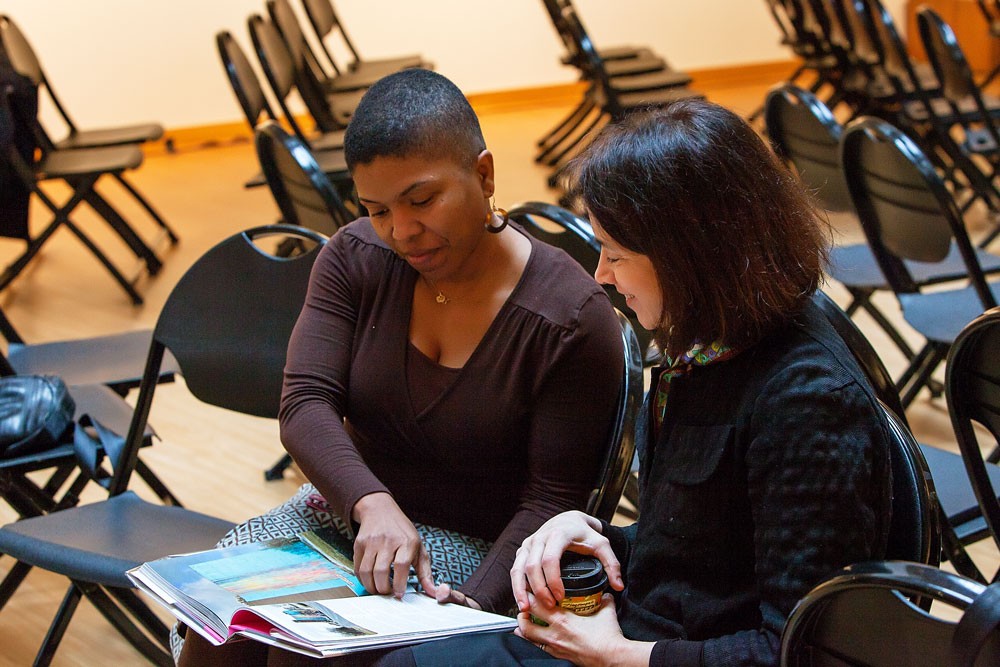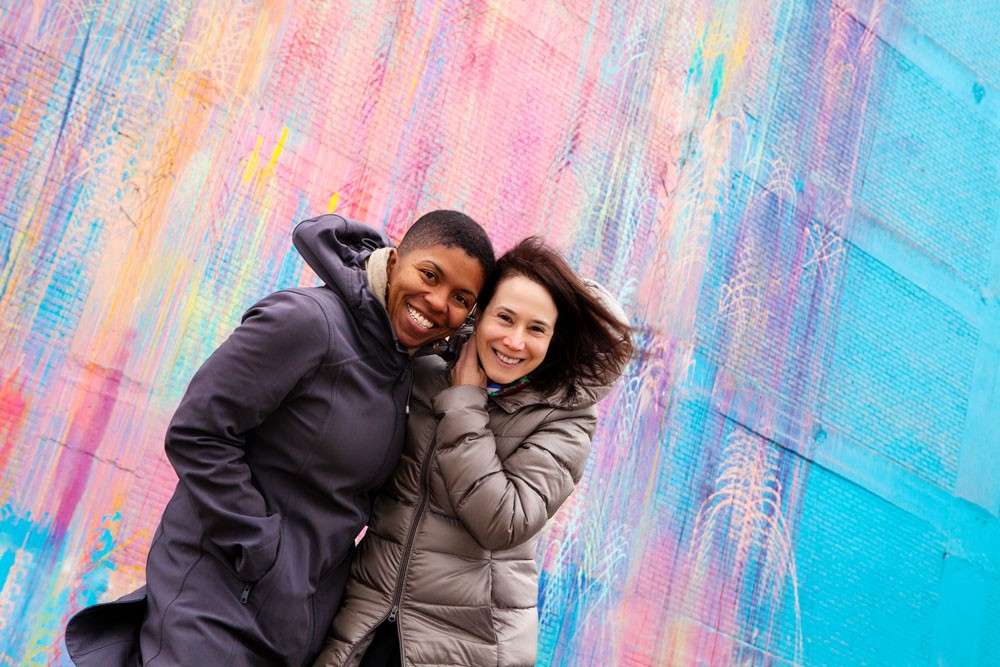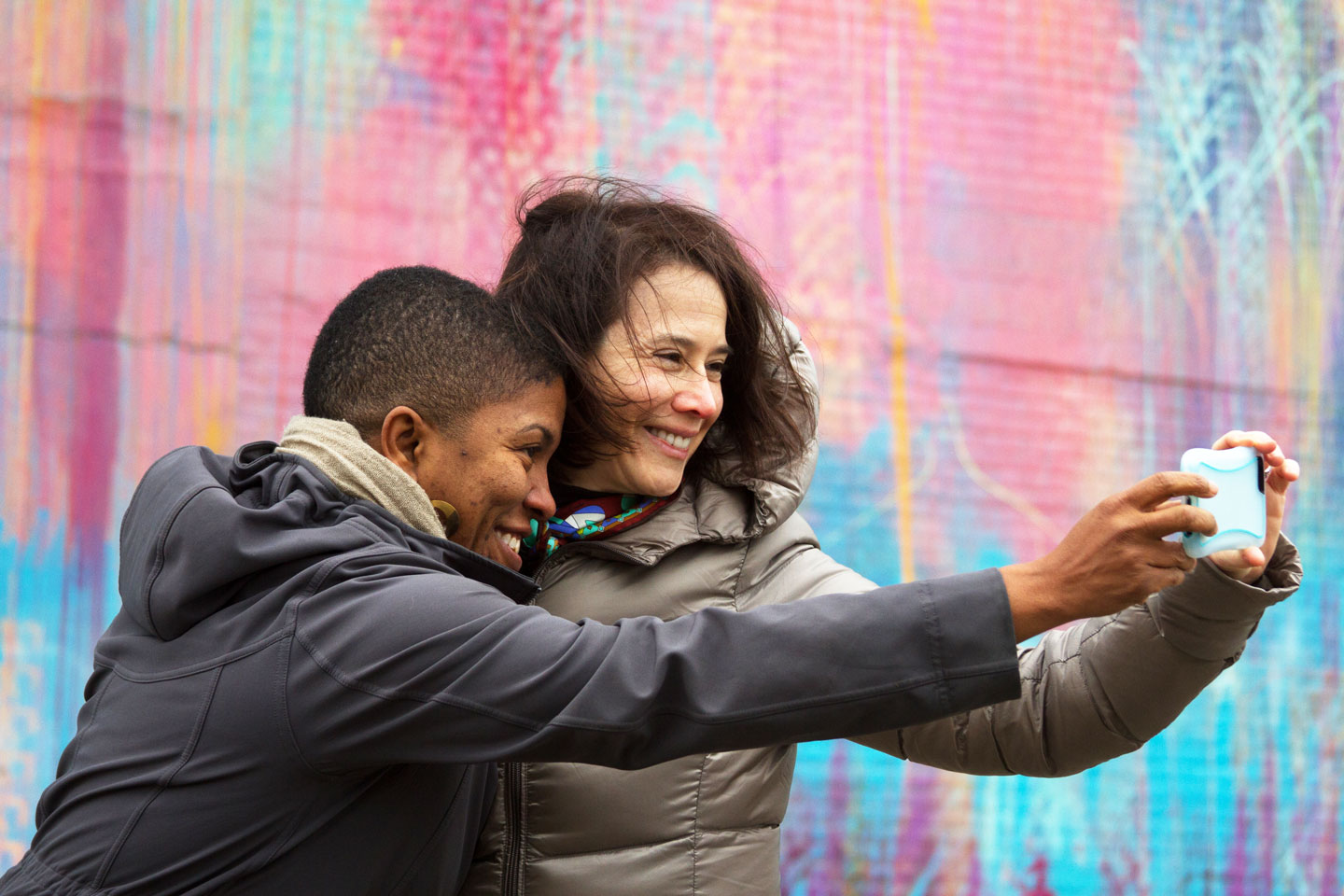Canvas Detroit
By Vivian Henoch, Editor myJewishDetroit
December 1, 2014
A masterful achievement five years in the making, Canvas Detroit, conceived and designed by Julie Pincus and written by Nichole Christian captures rare moments in Detroit’s ever-changing landscape through portraits of artists who have tested the limits of the city’s wild and public spaces.
Beyond Tyree Guyton, the “undisputed godfather of street art,” most of the artists who have adopted Detroit as their canvas work in brilliant obscurity. Who among us can positively identify a Bansky for instance? Where would we look to find the works of BASK, Katie Craig, Erik Howard (TAP), Cupcake Girls, Dabls, Kevin Joy, Matthew Eaton, Graem Whyte and Faina Lerman, Hygienic Dress League, Cobie Solomon? In their tenacious pursuit of the artists behind the art, Julie Pincus and Nichole Christian have collaborated in the telling of a far greater story, celebrating the art of Detroit at work, challenging us, dazzling us, sometimes infuriating us, yet always moving us forward.
Born and raised in metropolitan Detroit, and now living in New York City, Julie Pincus is an award-winning graphic designer specializing in brand identity and communications. Nichole Christian is a Detroit writer who began her career as a staff member for some of the nation’s top news outlets including the Wall Street Journal, Time magazine, the New York Times, and the Detroit Free Press. Canvas Detroit is a publication of Painted Turtle/Wayne State University Press (2014). Check out 22 photos from Canvas Detroit here.

In an interview with MyJewishDetroit, Julie Pincus and Nichole Christian discuss their collaboration on Canvas Detroit.
A Discussion with Nichole Christian and Julie Pincus of Canvas Detroit from Detroit Federation on Vimeo.
myJewishDetroit: On the surface, Canvas Detroit appears to be a book about art some might even consider to be graffiti . . . or a great show of Detroit chutzpah. It is art or chutzpah? And is there a difference?
Nichole: On the question, art or chutzpah: it’s a combination of the two. Detroit requires a certain extra push, extra strength and extra belief in yourself. And extra respect for the history. Because there’s so much about the city that screams, “Impossible!” If you stay stuck on that, then nothing happens.
But if you go beyond that, it’s just a helluva place to create.
Just look at the things that have been created here: this is the city that created the automotive industry; it started Motown. I’m not suggesting we turn back to nostalgia. We can start right here where we are. At this moment we have a whole city trying to show a country how we can do things differently.
How? We collaborate. We use what we have and we invest in our most important asset—that’s people.
myJewishDetroit. The notion of Detroit as a canvas has both a positive and negative connotation. Canvas Detroit paints a very powerful, positive image of the city. Tell us about your choices in creating the book.
Julie: Detroit is vast, and we found that to be an interesting problem and opportunity. The physical size of the city – the canvas, so to speak — presents its own set of solutions. Every neighborhood has its own personality. Corktown, for instance, has its own unique vibe. The Eastern Market presents another facet of the city that’s very strong and vibrant. And each area has attracted proponents who gravitate to that location and groups committed to revitalization in the city. So there’s a lot of creative activity going on from which to choose.
Nichole: There’s this notion that we have to become the next Brooklyn or the next . . . Someplace Else. I don’t think so. In the same way New York has a distinct character, so does Detroit. It’s just a question of embracing that spirit and allowing it to evolve.
Detroit is not a blank canvas. There is a narrative here. This is just a new chapter.
Julie: We’re at a turning point. It’s an exciting time to be in Detroit, and things are changing in the artwork too. There’s a lot more money, flowing in from foundations. Artists are starting to mine that. Artists are delving into grant writing and discovering ways to make Detroit a viable place to live and be an artist.
Nichole: Art is an invitation to start a deeper conversation about the city and the way creativity filters into other areas. If we’re going to define ourselves as an art city, art has to be part of the education process and accessible across the board. We’re not there yet. But what is happening is real and is energizing.

Julie: The fact that Dan Gilbert, for instance, tapped Matt Eaton as a consultant on the Z-Garage is fascinating to me. That project is a great example of sanctioned, curated street art starting the conversation.
Nichole: It’s a better story when you bring both established and emerging artists to the table. We need established artists who have made their living here and who have struggled to be here as much as we need folks who want to be here because Detroit is sexy and cool now.
Julie: That segues to a real challenge we had in the book. We had to make a lot of tough decisions on who was going to be in the book and who was not. This is where Nichole brought a lot to the table. We had moved far along in the creative process, and actually brought her in during the last six months of the project.
And she came in with fresh eyes and said, “You know, you really need to be inclusive in a way you’re not.” And I’m to blame for that to a certain degree, because my decisions were totally subjective.
Nichole: To Julie’s credit, she listened. It wasn’t a conversation so much about ego. It was about telling the whole story and telling it well. If I’m going to tell a story about my hometown, then the work needs to be something I’m proud of.
Julie: And to the credit of WSU Press Editor in Chief, Kathryn Wildfong, we had the kind of conversations that we needed to make this a meaningful project.
Nichole: Julie could have captured pictures that would fall squarely in the category of ruin porn. We all know there’s still an appetite for that kind of imagery, because that’s the Detroit people want to see. But there is not one image in the book that’s exploitative in that way.
Julie: As part of my contract, I had to raise money for the project. And there was some push-back, because people were afraid it was going to be another book capitalizing on imagery of the city in ruins. Actually, Nichole had a lot of the same trepidation about the project. She didn’t want to be instrumental in something that was going to contribute to another one-dimensional snapshot of the city.
Nichole: Julie’s tenacity on this project really speaks to the spirit of Detroit. My job was hard because I had a very narrow window – just six months – to get the job done. As a writer, I’m used to digging in and having to line things up myself. Julie had already completed a lot of the legwork. For me, the challenge was to make sure that I could bring a level of detail to the stories that matched the images.
myJewishDetroit: The stories are really wonderful windows into the work. And they really bring the artists to life in vivid portraits. Was that your objective?
Julie: So much of the art is hidden. And many of the artists themselves can be elusive. Some of their work is here to stay, and some has disappeared. It’s all a part of the process. But that’s what has made this project so exciting. Getting to know the artists on a deeper level has been gratifying. But it was impossible to include every artist we loved in the book.
Nichole: We may have come to this project with different viewpoints, but I think we shared a genuine curiosity about the people behind the work and the passion that drives them.
Julie: It’s funny, but I didn’t know until I read it in the Forward that Nichole almost said ‘no’ to me.
Nichole: My forward was the last thing I wrote and I struggled with it because what I had to finally own was the fact that the process changed me. I really had to come to grips with some things while interviewing the artists.
Detroit is an easy place to look at in very narrow ways and to become defensive about, if your a native. We’ve been forced to.
A lot of media have done this city a disservice and in a lot of ways we’ve bought their version of Detroit’s story. Somehow we’ve learned to look away and forget the depth of possibility alive in this city. So, if you want our book with a line, if anything, it’s “Take another look.”




